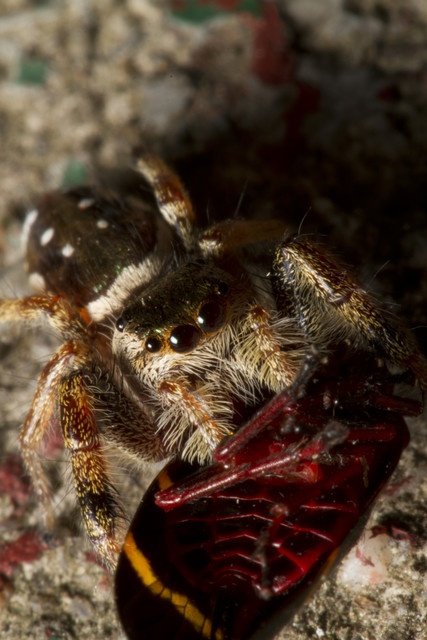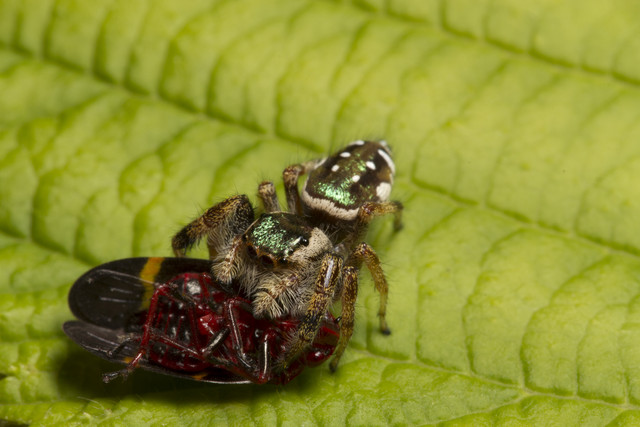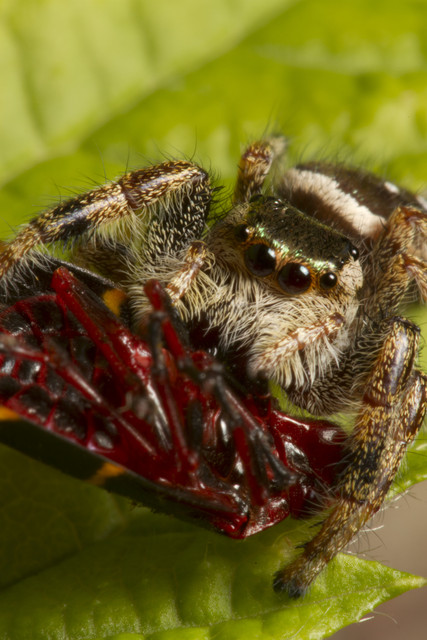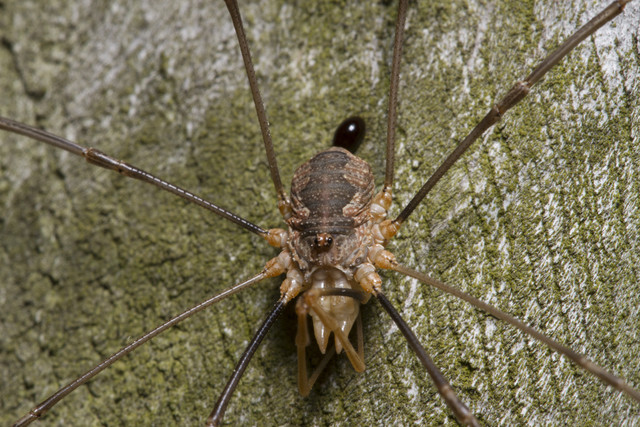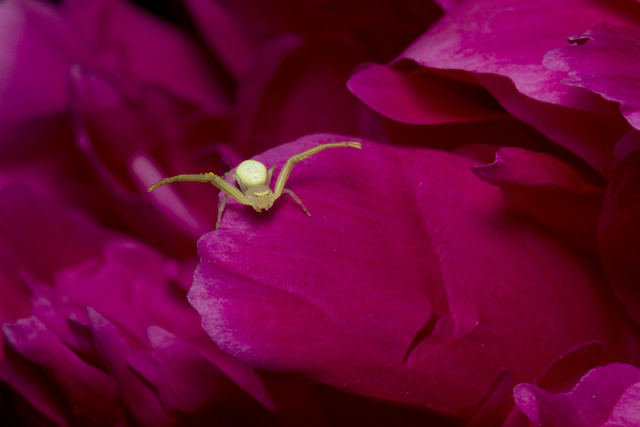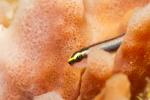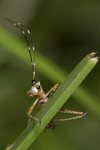spider
The Smallest Spider I've Ever Seen!
ktuli — Mon, 08/01/2011 - 20:29
Ok - you were warned. I told you that we were getting back to the bugs and spiders today... well, the spiders at least for today.
I saw this tiny little guy on one of the bushes out in our front yard. And when I say tiny, I mean like head of a pin tiny! Based on my calculations (which are this point are pretty much eyeballed) - this guy is about 2mm in size (maybe... and I do mean maybe... his legs could have reached 3mm fully stretched out). Despite the tiny size, I saw him make jumps of over 65mm! He was absolutely fearless.
This is the only shot of him that I managed to get, and unfortunately I wasn't able to find him again after running inside to get my tele-converter. I've cropped down to show a bit more of the detail (just mouseover to see the original version).
Technical Data:Canon EOS 7D, Canon EF 100mm f/2.8L Macro IS USM, 1/250 sec at f/16. Canon Speedlight 580EX II flash in auto mode and wireless control. Image Stabilization on. ISO 160. RAW processing and cropped in Adobe Camera Raw.
I know many people don't like spiders, but this tiny guy just fascinates me. The thought that there is a beating heart, a tiny brain, everything. It is just incredible. I don't know if this is a juvenile or a full grown adult (I still have yet to find a spider ID book worth buying), so I have no clue on the species here. Regardless, I really love those semi-translucent legs!
Come on... you have to admit that this tiny little guy is pretty cool... and at 2mm, he is absolutely 100% harmless to everything except those other pests in your garden that you don't want anyway!
Give spiders a chance.
- Bill
Skull-Faced Jumping Spider
ktuli — Sun, 07/17/2011 - 18:24
Ok - I know... that title alone is enough to turn anyone away from this post, but this spider really does look like he has a skull on his face - it is uncanny. Plus, I promise to take a little break from the spiders after today. I have more shots to share of this guy, but I'm going to spread them out a bit and switch back to some flowers and some other bugs (including a hummingbird hawk moth!) over the coming days.
But check this guy out...
Technical Data: Canon EOS 7D, Canon EF 100mm f/2.8L Macro IS USM, 1/250 sec at f/16. Canon Speedlight 580EX II flash in auto mode and wireless control. Image Stabilization on. ISO 160. RAW processing in Adobe Camera Raw.
Going to skip the discussion for now... I've got a bunch of photos to process so I have other stuff than spiders to share... ;)
Thanks for stopping in.
- Bill
Jumping Spider Dinner (part 4)
ktuli — Thu, 07/14/2011 - 17:31
OK - just an assortment to finish up with this jumping spider (sorry - still haven't been able to ID it).
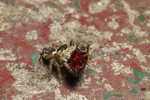 |
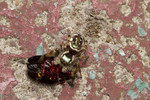 |
 |
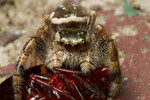 |
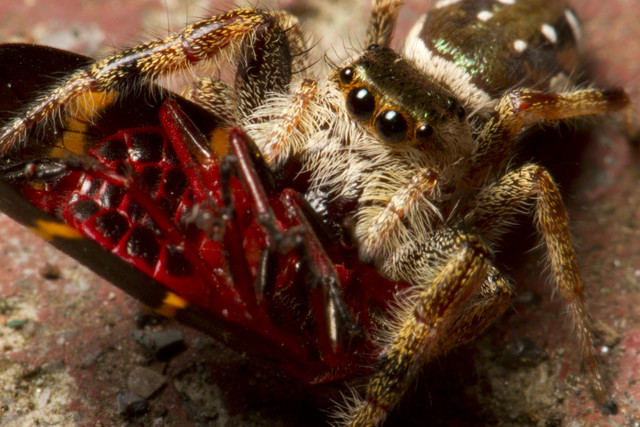 |
|||
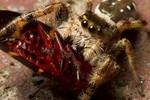 |
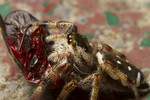 |
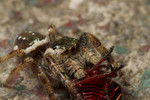 |
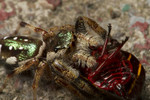 |
Technical Data: Canon EOS 7D, Canon EF 100mm f/2.8L Macro IS USM with Kenko Teleplus PRO 300 "DG" AF 2x Teleconverter (except first 2), 1/250 sec at f/16. Canon Speedlight 580EX II flash in auto mode and wireless control. Image Stabilization on. ISO 160. RAW processing in Adobe Camera Raw.
Thanks for looking. And don't forget to go vote on the post here!
- Bill
Poll: Jumping Spider Dinner (part 3)
ktuli — Wed, 07/13/2011 - 19:37
As I was working with this guy, I was trying many different angles - some because he would move around, some because I just wanted to get as many angles as possible before he got tired of having a camera shoved in his face.
When I tried this angle, my camera flash bracket put the flash to the side of the spider. I could have moved it, but then I thought about how a shot would look with the light coming from the side and producing this strong shadow on the other side of the spider.
Fortunately, it worked exactly as I had envisioned before clicking the shutter. The side lighting caused a very distinct shadow to the far side of the spider - producing an effect that makes the spider look much larger than he really is. In truth, because of the setup I was using (basically a 2:1 magnification), this spider was already looking pretty giant in the viewfinder. However, that big shadow just increases that feeling in my opinion.
I shared this on a forum I frequent, and received lack-luster responses to the usage of the flash in this manner. One suggestion was to use a reflector to bounce some of the flash light back into the right side. This probably would have still kept the distinct shadow, but would have helped to bring back some of the details on the right side of the spider.
I don't know if that would have really done much, or if I would have liked it better - I personally am very pleased with this shot and the feeling it produces for me.
Technical Data: Canon EOS 7D, Canon EF 100mm f/2.8L Macro IS USM with Kenko Teleplus PRO 300 "DG" AF 2x Teleconverter, 1/250 sec at f/16. Canon Speedlight 580EX II flash in auto mode and wireless control. Image Stabilization on. ISO 160. RAW processing in Adobe Camera Raw.
So cast your vote and let me know what you think... whether the strong shadow works, or if it ruins the image. Drop me a comment and let me know why you voted the way you did (sorry - no option will be provided for 'the spider ruined the image, not the shadow!'). Remember - you don't have to know all about photography to be able to vote on what you like...
Thanks for stopping by!
- Bill
Jumping Spider Dinner (part 2)
ktuli — Tue, 07/12/2011 - 19:06
Here's another of that jumping spider with his dinner. This one was taken without the teleconverter, so the magnification isn't as dramatic, but I feel this shot has a bit better composition than just a super-macro shot.
Technical Data: Canon EOS 7D, Canon EF 100mm f/2.8L Macro IS USM, 1/250 sec at f/16. Canon Speedlight 580EX II flash in auto mode and wireless control. Image Stabilization on. ISO 160. RAW processing in Adobe Camera Raw.
Why This Photo: When I found this little guy digging into his dinner, and saw what a cool jumping spider he was, I simply had to see what kind of shots I could manage with him.
What Works: The best item of this shot is the way the metallic green color shows up on the spider's body. This color only appeared on certain angles, so I did have to make some sacrifices to get it, but I think it was worth it. The DoF works to get almost the whole spider in clarity (only possible because of the light provided by the 580EX), and the focus is sharp right on the spider's face. And the bright green leaf produces a nice pleasing background.
What Doesn't Work: To get the green metallic color, I had to sacrifice getting the spider's face and eye contact (many of the other shots have great catchlights in the eyes). Also, the composition would probably have been better if the spider were in the upper right corner, but that simply depended on where the spider was on the leaf (in fact, the edge of the leaf shows in the very bottom left corner).
What do you think? Drop me a comment and let me know.
- Bill
Jumping Spider Dinner (part 1)
ktuli — Sun, 07/10/2011 - 15:36
Ok - I am sorry to start another multi-part series right after beginning a different oe, but I found this little guy last night and really want to start sharing the photos. So I promise to get back to the assassin bug, but it will just be interspersed with this jumping spider.
I found this guy on a leaf on one of the plants out front. Because of where he was located, I simply decided to pinch off the leaf he was on and relocate him to the floor of our front porch. He had obviously just captured this insect (the legs were still twitching) he was starting to tuck into, so I wanted to be careful not to cause him to lose his meal. Apparently there was little risk of that. Over the twenty minutes or so that I was photographing him, he never once let go of it, and probably didn't ever stop eating (by the end, the bug was much smaller and shriveled).
As if typical for me these days, I shot these using the Speedlight 580EX II on a Siegelight bracket and Lumiquest Mini-Softbox and controlled wirelessly by the Canon 7D and my new favorite lens in the Canon EF 100mm f/2.8L Macro, and after a few initial shots with that setup - I usually toss in the Kenko 2x teleconverter. All told, the setup allows me to get shots that I never would have imagined possible before. The Canon 100mm lens provided some excellent image quality, and the image stabilization helps to let me shoot handheld (which I probably shouldn't do), while the flash allows me to stop down the aperture (often to f/16 or higher) for greater depth of field, and finally the teleconverter allows me get 2:1 (twice life-size) magnification.
What that all translates to is getting to see the culinary habits of jumping spiders in incredible detail - though I am sure there are those of you who don't think that is a good thing, but oh well. :)
Technical Data: Canon EOS 7D, Canon EF 100mm f/2.8L Macro IS USM with Kenko Teleplus PRO 300 "DG" AF 2x Teleconverter, 1/250 sec at f/16. Canon Speedlight 580EX II flash in auto mode and wireless control. Image Stabilization on. ISO 160. RAW processing in Adobe Camera Raw.
Stay tuned and I'll continue sharing shots of the assassin bug and this jumping spider.
- Bill
Jumping Spider Web
ktuli — Wed, 07/06/2011 - 19:18
So I didn't realize that some jumping spiders actually build themselves a web. I'm not sure what the purpose of this little spider's web is - whether it is for trapping food, or just protection overnight, or for laying eggs. But I sat and watched this little spider spin this web for about fifteen minutes the one evening (and then I forgot this photo was still sitting on the card)
Technical Data: Canon EOS 7D, Canon EF 100mm f/2.8L Macro IS USM, 1/250 sec at f/16. Canon Speedlight 580EX II flash in auto mode and wireless control. Image Stabilization on. ISO 160. RAW processing in Adobe Camera Raw.
Sorry I have been lazy with posting recently... just been having a hard time keeping myself motivated, and I've been trying to get outside every once in a while and enjoy the weather and get some exercise. I don't know if I'll pick up with regular posts again any time soon or not, so I'm not going to make any promises.
Thanks for stopping by.
- Bill
Harvestman
ktuli — Wed, 06/08/2011 - 18:45
Ok - I will admit... if you don't like spiders, you probably won't like this shot. Though technically, this isn't a spider. It is in the arachnid class, but it is in the Opiliones order.
But either way, they are much more alien looking than spiders (and if I'm honest, much uglier!).
Their common names are Harvestmen or Daddy-Longlegs, and you've likely seen them before but probably not like this.
They differ from spiders in a number of ways. First, they possess no silk glands nor venom glands - so they're completely harmless (though this one seems to have something that looks like semi-large fangs). Their body segments are fused (spiders have two body segments - cephalothorax and abdomen), and only have a single pair of eyes (spiders have four pairs of eyes). Harvestmen can also eat solid foods, whereas spiders are only able to ingest liquids.
Ok - if you're still here with me... you must be willing to see the shot...
Technical Data: Canon EOS 7D, Canon EF 100mm f/2.8L Macro IS USM, 1/250 sec at f/11. Canon Speedlight 580EX II flash in auto mode and wireless control. Image Stabilization on. ISO 160. RAW processing in Adobe Camera Raw.
Obviously, the legs on this guy weren't even going to come close to staying in the frame if I was going to get the same level of detail on the body. Most of those legs don't even have the first joint in the shot. The body on this harvestman was maybe 5mm long, so extremely tiny.
Pretty hard to get the detail here but I think I did pretty well.
My apologies if you're freaked out by that shot...
- Bill
Return of the Crab Spider (part 2)
ktuli — Tue, 06/07/2011 - 17:16
Ok - back to the crab spider that was living in one of the peony flowers in our garden for today. This was a very tiny little spider, and today's shot gives a little more scale by backing up a little and showing more of the flower along with the spider.
Technical Data: Canon EOS 7D, Canon EF 100mm f/2.8L Macro IS USM, 1/250 sec at f/16. Canon Speedlight 580EX II flash in auto mode and wireless control. Image Stabilization on. ISO 160. RAW processing in Adobe Camera Raw.
By backing up a little, I manage to show a little scale (though nothing near normal size). I think often times, folks think that these bugs I find are the size of my hand because of the magnification the macro lens produces. In reality (and if my math is correct) had an arm span of only about 9-11mm. Pretty tiny.
The other thing this shot shows is some of the behavior of the crab spider. (This part will probably creep out those of you who don't like spiders, so skip the rest of this paragraph if you're in that group). Crab spiders are pretty aggressive. They often take down prey much much larger than themselves, and they do that with those long, powerful, front legs. They lie in wait and pounce on their prey, holding it with those long legs while injecting their venom. Both crab spiders that I have photographed showed basically no fear of me at all, including threat displays and lunging forward towards my hands and the camera. Very impressive little attitudes. Despite their attitudes and ability to take down large prey, they are harmless to humans.
Often times, crab spiders live on flowers that are close to the color they are (some can slightly change their colors to match the flowers exactly), so this little guy living in a pink flower is kind of strange. The camouflage at work here is actually based on the pollen stamens in the flower. When hiding between the petals, this little spider was about the size and color of the yellow pollen stamens which are layered between the different petals in a peony flower. And it was very quick to move around the flower, quickly climbing between petals, crawling from one side to the other side of a petal, and traversing the whole flower with surprising speed - though it never moved very quickly, just very directly.
See - there are reasons why I am fascinated by little critters like this. I know they're often considered creepy or even scary, but they really are interesting creatures.
- Bill
Return of the Crab Spider
ktuli — Thu, 06/02/2011 - 19:54
Yeah - I know... that sounds like a B horror film title, but if you remember - I had a run-in with a crab spider last year too (posts: 1, 2, and 3). Unfortunately, I have some more photos to process tonight, so just sharing one photo, and I'll discuss details on future posts.
Technical Data: Canon EOS 7D, Canon EF 100mm f/2.8L Macro IS USM with Kenko Teleplus PRO 300 "DG" AF 2x Teleconverter, 1/250 sec at f/16. Canon Speedlight 580EX II flash in auto mode and wireless control. Image Stabilization on. ISO 160. RAW processing in Adobe Camera Raw.
I have some really fun stuff to share... soon.
- Bill



